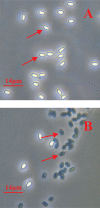Transcriptome sequencing and characterization of ungerminated and germinated spores of Nosema bombycis
- PMID: 26837419
- PMCID: PMC4885133
- DOI: 10.1093/abbs/gmv140
Transcriptome sequencing and characterization of ungerminated and germinated spores of Nosema bombycis
Abstract
Nosema bombycis is an obligate intracellular parasitic fungus that utilizes a distinctive mechanism to infect Bombyx mori. Germination, an indispensible process through which microsporidia infect the host cells, is regarded as a key developmental turning point for microsporidia from dormant state to reproduction state. Thus, elucidating the transcriptome changes before and after germination is crucial for parasite control. However, the molecular basis of germination of microsporidia remains unknown. To investigate this germination process, the transcriptome of N. bombycis ungerminated spores and germinated spores were sequenced and analyzed. More than 60 million high-quality transcript reads were generated from these two groups using RNA-Seq technology. After assembly, 2756 and 2690 unigenes were identified, respectively, and subsequently annotated based on known proteins. After analysis of differentially expressed genes, 66 genes were identified to be differentially expressed (P ≤ 0.05) between these two groups. A protein phosphatase-associated gene was first identified to be significantly up-regulated as determined by RNA-Seq and immunoblot analysis, indicating that dephosphorylation might potentially contribute to microsporidia germination. The DEGs that encode proteins involved in glycometabolism, spore wall proteins and ricin B lectin of N. bombycis were also analyzed. Gene Ontology and Kyoto Encyclopedia of Genes and Genomes analyses revealed genes responsible for some specific biological functions and processes. The datasets generated in this study provide a basic characterization of the transcriptome changes in N. bombycis during germination. The analysis of transcriptome data and identification of certain functional genes which are robust candidate genes related to germination will help to provide a deep understanding of spore germination and invasion.
Keywords: Nosema bombycis; dephosphorylation; germination; microsporidia; transcriptome.
© The Author 2016. Published by ABBS Editorial Office in association with Oxford University Press on behalf of the Institute of Biochemistry and Cell Biology, Shanghai Institutes for Biological Sciences, Chinese Academy of Sciences.
Figures






Similar articles
-
Morphology and Transcriptome Analysis of Nosema bombycis Sporoplasm and Insights into the Initial Infection of Microsporidia.mSphere. 2020 Feb 12;5(1):e00958-19. doi: 10.1128/mSphere.00958-19. mSphere. 2020. PMID: 32051240 Free PMC article.
-
Ricin-B-lectin enhances microsporidia Nosema bombycis infection in BmN cells from silkworm Bombyx mori.Acta Biochim Biophys Sin (Shanghai). 2016 Nov;48(11):1050-1057. doi: 10.1093/abbs/gmw093. Epub 2016 Sep 20. Acta Biochim Biophys Sin (Shanghai). 2016. PMID: 27649890
-
Molecular and biochemical responses in the midgut of the silkworm, Bombyx mori, infected with Nosema bombycis.Parasit Vectors. 2018 Mar 6;11(1):147. doi: 10.1186/s13071-018-2755-2. Parasit Vectors. 2018. PMID: 29510742 Free PMC article.
-
Nosema bombycis: A remarkable unicellular parasite infecting insects.J Eukaryot Microbiol. 2024 Sep-Oct;71(5):e13045. doi: 10.1111/jeu.13045. Epub 2024 Aug 2. J Eukaryot Microbiol. 2024. PMID: 39095558 Review.
-
The roles of microsporidia spore wall proteins in the spore wall formation and polar tube anchorage to spore wall during development and infection processes.Exp Parasitol. 2018 Apr;187:93-100. doi: 10.1016/j.exppara.2018.03.007. Epub 2018 Mar 6. Exp Parasitol. 2018. PMID: 29522765 Review.
Cited by
-
The Sorting and Transport of the Cargo Protein CcSnc1 by the Retromer Complex Regulate the Growth, Development, and Pathogenicity of Corynespora cassiicola.J Fungi (Basel). 2024 Oct 14;10(10):714. doi: 10.3390/jof10100714. J Fungi (Basel). 2024. PMID: 39452666 Free PMC article.
-
Microsporidian Introns Retained against a Background of Genome Reduction: Characterization of an Unusual Set of Introns.Genome Biol Evol. 2019 Jan 1;11(1):263-269. doi: 10.1093/gbe/evy260. Genome Biol Evol. 2019. PMID: 30496512 Free PMC article.
-
E. hellem Ser/Thr protein phosphatase PP1 targets the DC MAPK pathway and impairs immune functions.Life Sci Alliance. 2024 Jan 10;7(4):e202302375. doi: 10.26508/lsa.202302375. Print 2024 Apr. Life Sci Alliance. 2024. PMID: 38199846 Free PMC article.
-
Easy labeling of proliferative phase and sporogonic phase of microsporidia Nosema bombycis in host cells.PLoS One. 2017 Jun 22;12(6):e0179618. doi: 10.1371/journal.pone.0179618. eCollection 2017. PLoS One. 2017. PMID: 28640848 Free PMC article.
-
Morphology and Transcriptome Analysis of Nosema bombycis Sporoplasm and Insights into the Initial Infection of Microsporidia.mSphere. 2020 Feb 12;5(1):e00958-19. doi: 10.1128/mSphere.00958-19. mSphere. 2020. PMID: 32051240 Free PMC article.
References
-
- Bhat SA, Bashir I, Kamili AS. Microsporidiosis of silkworm, Bombyx mori L. (Lepidoptera— bombycidae): a review. Afr J Agr Res 2009, 4: 1519–1523.
-
- Becnel JJ, Andreadis TG. Microsporidia in insect. In: Wittner M, Weiss LM eds. The Microsporidia and Microsporidiosis. Washington, DC: ASM Press, 1999, 447–501.
-
- Vavra J, Larsson JIR. Structure of the microsporidia. In: Wittner M, Weiss LM eds. The Microsporidia and Microsporidiosis. Washington, DC: ASM Press, 1999, 7–84.
Publication types
MeSH terms
LinkOut - more resources
Full Text Sources
Other Literature Sources

